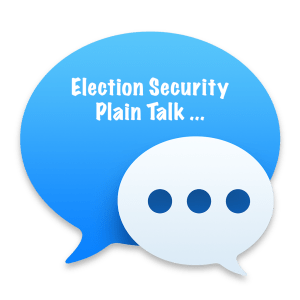Plain Talk Series on Election Security #1: “Paper” vs. “Machine Voting” Debunked
John Sebes

This is the first of a 7-part series of election security vignettes intentionally kept as brief as possible to stick to the main point of the title above. Its intended to acquaint relatively new-comers to election integrity and security, and that includes anyone and everyone from concerned citizens, to journalists, to policy makers.
It’s great that election security is so much in the news and political debate – we sure do need more security in U.S. elections. It’s not so great, though, that much of the debate includes some simple but gigantic misunderstandings that are really slowing down state and federal legislation on election security.
Here’s one misunderstanding: that this debate somehow pits paper voting against machine voting.
Here’s just one common example: claims that various current legislative initiatives will have the Federal government requiring states to “go back to paper” voting, as though people will be forced to use pen and paper.
Here are the actual and simple facts:
- All over the U.S., both paper voting and machine voting are required:
- Paper and pen voting is needed for absentee and by mail voting.
- Voting machines are legally required for accessibility of voting for voters for whom pen and paper aren’t appropriate or possible.
- None of the current legislation would change that.
- What will change: getting rid of old voting machines (called “DREs”) that are paperless or that provide a kind of paper record that has proved to not really help voters.
That’s it. Really. Instead of the old DRE machines, we will have newer “Ballot Marking Devices” (BMDs) that produce a paper record that will be counted by optical scan, the same as hand marked paper ballots. Now there are some concerns and issues with those printed records and we cover that elsewhere, and I’ll say some more about that elsewhere)
The result: equal protection for all voters. No more paperless machine voters lacking the protections that hand/paper voters have from their votes being mis-recorded without detection or correction – and being essentially shut out of recounts when recounts are needed. In other words:
- If you’re a voter who likes your options for hand marking a paper ballot, you’ll have those same options. (Note: there is nuance to this to be explained elsewhere.)
- If you’re a voter who likes your options for using voting machines, you’ll have essentially the same options, but with newer and better machines.
And with a paper record from every voter, every election office across the country will all have the ability to conduct routine audits to detect and correct computer glitches that name as winner a candidate who didn’t get the most votes.
And that’s the main point! Enabling all U.S. election officials to prevent wrong election outcomes, not just those that have already stamped out paperless voting.
Next: Costs of Ditching Paperless Voting.
To read more, here are all of the articles in this Election Security Plain Talk Series.



